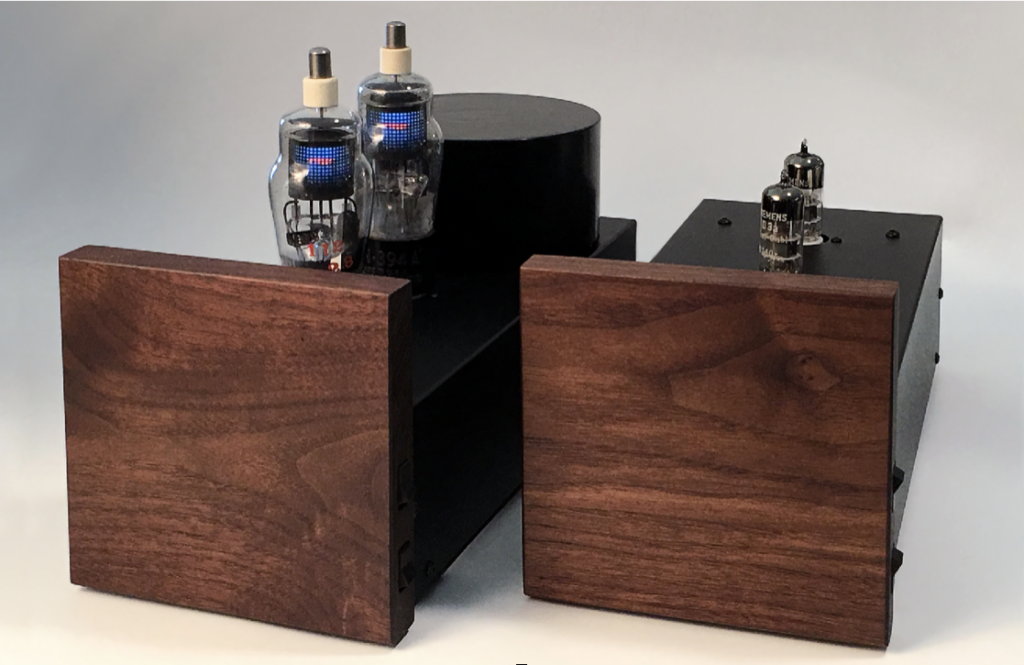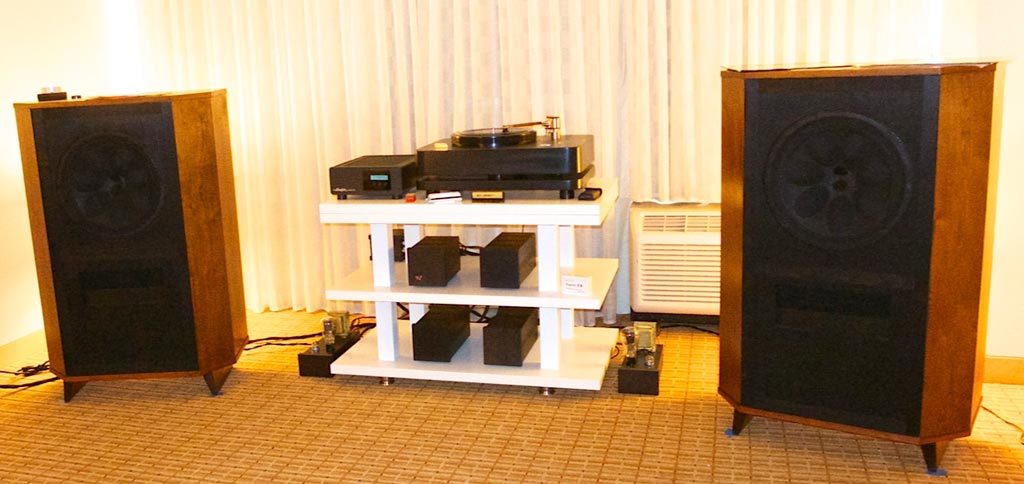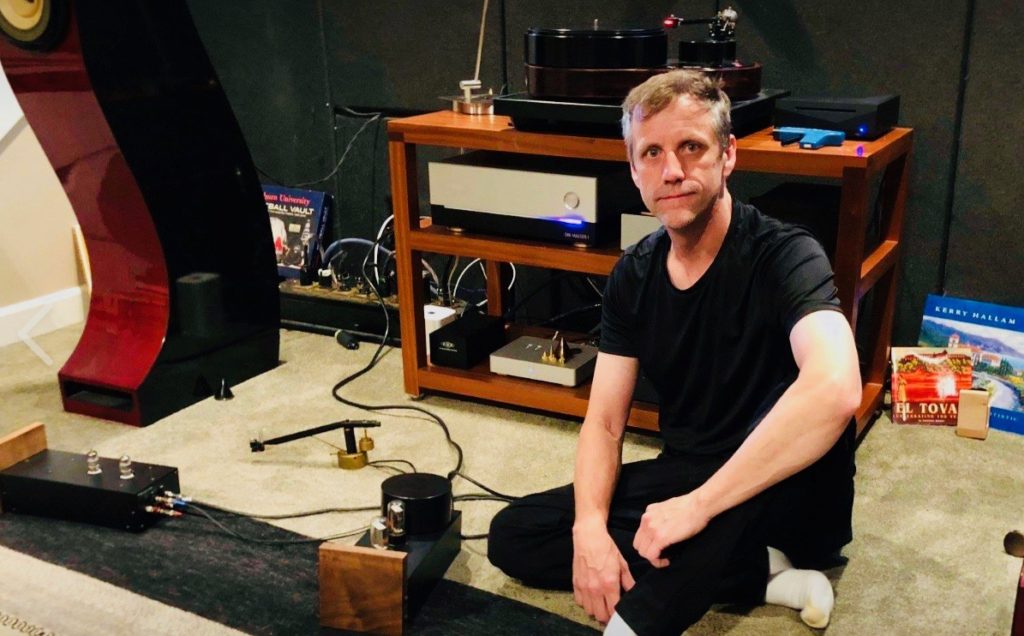
Who is Emia?
Before diving into this review, it might be helpful for me to provide a little information on Emia. Jeffrey Jackson and Dave Slagle created Emia to fulfill the need for more affordable, very high-end audio components using clever design and quality parts. On the EMIA’s website, it says, “EMIA represents a way of thinking or a concept if you will, rather than a specific product. Our unique way of thinking blends the knowledge and experience of Jackson of Experience Music and Slagle of Intact Audio with the goal of integrating the subjective and the objective to further both the art and science of musical reproduction.”
While so many people today are simply trying to copy and bring vintage technology to market, Emia strives to understand the underlying concepts of vintage designs. They then apply these concepts to contemporary sound reproduction through the introduction of their new designs.
I was excited to have Dave Slagle come by my home early in August, when he was in the San Francisco Bay Area for a family wedding. He brought his strain gauge cartridge system with him, and he came over to set it up for me. Dave I want to say thank you again for taking the time to do this.
While we were visiting, I asked Dave about how the partnership with Jefferey Jackson came about. Dave said he was so immersed in the DIY community that he wasn’t really thinking about high-end audio, but people kept asking if he could make some finished products for them. He said he came to realize that there were people who were just interested in building their own stuff.
At about that same time Jackson, was making custom-designed amplifiers and speakers that were beautiful but very expensive, and he kept getting requests for equipment that cost less than nearly six figures. So Jackson and Slagle started Emia to build equipment with unassuming chassis designs that put the bling on the inside as Slagle is fond of saying. All of their products are hand-made in their workshops. EMIA is not even close to being a mainstream high-end audio company. You have to place an order and most often wait for the product, but I promise you the wait will be worth it.
Cartridge Design
Strain gauge phono cartridges are the stuff of legend, but most audiophiles have never heard one. If you have heard one, it was probably one of Peter Ledermann’s beautiful and beautiful sounding Soundsmith SGs at a show. I lived with one of these wonderful cartridges for around three years, and I still consider it to be one of the best phono cartridges I have ever heard.
So what is the difference between a strain gauge and a magnetic cartridge? Perhaps the best known early strain gauge was the Win Strain Gauge cartridge. Sao Win made them off and on for decades. Panasonic also made some years ago, and some of these are still in service today. One of the reasons for their popularity was that the strain gauge design was an easy way to pick up the rear channels for quadraphonics. Jeff Rowland was so taken with the Panasonic strain gauge that he made a power device for it.
Personally, I’ve never heard either a Win or Panasonic strain gauge cartridge until now, though my audio bud, Steve, says he used to own a Win Labs cartridge and loved it. Strain gauge cartridges are unlike traditional moving magnet or moving coil cartridges in that they do not produce voltage or current. In contrast, it responds to mechanical movement or displacement of the grooves by changing resistance. Thus, it requires the use of a separate, dedicated electronic device to generate a direct current in which changes in resistance can then be converted into an analog signal. (Because of the resistance produced by the cartridge, it must be used with a special phono-preamp that, in essence, provides a power supply. Whereas typical cartridges respond to velocity, the strain gauge responds to displacement. As such, the strain gauge does not require an RIAA correction.

The first time I heard any of the Emia products was at the 2013 Rocky Mountain Audio Fest in a room that featured Win Tinnon’s Saskia II idler driver turntable, Dave Slagle’s Emia amps, and a pair of RCA LC-1A LS-11 speakers. This pair of speakers was built the same year I was born, 1954, while the idler drive turntable and SET amps are older technology than that. Still, the sound was incredible. This was also my first and only time until now to hear the Emia Strain Gauge Cartridge System. The room was so emotionally involving that I awarded it as one of “My Three Favorite Rooms”.
Unlike the Soundsmith, the Emia used a modified Panasonic EPC-451 cartridge paired with a vacuum tube based amplification stage. The body is made of Dymondwood®, the cantilever is now made of boron, and the stylus is a Micro-Ridge line contact. The other big difference with the Emia is that the phono equalizer, phono preamp, and power supply are all tubed; it even uses tube rectification.
Another difference is that instead of AC, they use a battery power that will play for about 24 hours straight, but when you turn off the tubes the battery is charged. There is also no need for biasing the tubes, the unit is simply plug-and-play allowing you to roll tubes to find the “tone” you want. There are also two switchable filter sections if you want to bring the EQ closer to the RIAA ideal. The beauty of the way the filters are designed is that they are relay switched shunt filters so when they are in the off position, there is no effect on the sound.
The Hotrod Concept
I had dinner with some friends the other night at our favorite Cuban restaurant. Sitting out front of the restaurant was a 55 Chevrolet Bel Air. It was a low rider and painted two-tone metallic purple with white leather seats piped in purple. This car is always parked out front, and it has that hotrod look.
Back in the 90s, Meadowlark Audio of San Diego, CA, made a great line of affordable speakers that they also offered in what they called a hotrod version. Unlike the purple Chevy, they looked just the same on the outside but had better parts on the inside. This terminology caught on for a while, but I think the products from Emia bring this concept to life more than ever in audio. I happen to like the simplicity of their looks and their smaller size, but I have to admit no one has ever looked at them in my system and praised their looks, but I don’t care and neither do Jackson or Slagle. These aren’t hotrods to look at, but man do they perform!
Review System and Setup
I used the Emia SG in my reference system. I removed my DS Audio Master1 Optical Cartridge System ($22,500), and in its place put in the Emia Strain Gauge System. I used my AMG V12 turntable and the AMG V12Turbo tonearm, placed on the HRS M3X-1921-AMG isolation platform made for the V12. I used three power amps for the review; the First Watt SIT-3, the LTA Ultralinear and the LTA MZ2. For a linestage, I used the EMIA Remote Autoformer, and the speakers were my Teresonic XRs.
As I said earlier, Dave came by my house and set up the Emia gauge for me, but the setup was pretty straightforward. The phono cartridge is nice and straight across the front which makes it much easier to set up than some. The Micro-Ridge line contact is an extreme profile stylus, and the best sound can be had from a careful adjustment of the SRA and Azimuth. Tracking force should be in the 2.0-2.5g range. The interesting part of setting up this cartridge are all of the choices you have with this preamp equalizer. The power supply uses a pair of 6DA4 rectifier tubes. You have a choice with the signal tubes between D3A, 7788, E280F, and 6J11P-E (6Ж11ПE) tubes. David and I listened to several combinations and they sounded great.

Dave Slagel setting the strain gague up in my listening room. Thanks again, Dave for this extra service!
Listening
The Emia strain gauge tracked very well but was not quite as quiet in the groves as the Soundsmith strain gauge or my DS Audio Master1. The difference was very slight, but it was there. It was quieter in the groves, however, than an Ortofon SPU.
The Emia strain gauge sounds like beautiful music, full-bodied with great colorful textures that are truly musical. This cartridge had all of this along with great musical scale with exceptional dynamics, and it brings a sense of exciting drama to the appropriate music. The midrange is the heart of the music, and the Emia cartridge has a great heart. With the Emia music came to life and just flow into the room. No, the transients aren’t as fast nor is the sound as transparent as some, but the timbre and tone of voices and instruments were so right I didn’t care. I want you to know the Emia, sounds alive, beautiful, big, and it brings the vivid colors of live music to your listening room. Voices are lush, but not too lush; they just flowed into my room with this cartridge in my system.
The timing and cadence of voices was also very convincing. I have seldom heard, male or female, vocals sound more alive. The sound was pure, simple, and lifelike. The cartridge was so organic that voices never sounded detached from a body. Instead, it was like there was a whole person singing just for you. You can listen to Ella, Louie, or Frank, and you will be amazed at how their unique phrasing comes through into your room.
With all this, you also get bass that has tone, breadth and power. I’m not going to go through a blow by blow account of listening to different LPs. No, what I need most to say about the Emia Strain Gauge cartridge system can be said in much fewer words, tt just makes listening to LPs a whole lot of fun. It makes them sound dramatic. They have great scale, and they simply come to life. In many ways, this cartridge system has the magic of a great SET amp with its special way of breathing life into voices and instruments. Lastly, it also has such a beautiful, rich harmonic structure. One of the things I love about the Emia is its effortless way of reproducing sound, whether its drums, strings, horns, or the human voice.
Conclusion
The Emia Strain Gauge Cartridge System is certainly not a plug-and-play product. What comes to mind is the difference in two cars I’ve owned, a vintage Jaguar and a new BMW 5 series. The BMW is an extremely fine automobile and is easy to drive and maintain. The Jaguar was a thing of beauty with a soul of its own, but it was a much more hands-on driving experience. This is a great comparison between the Emia Strain Gauge and most modern phono cartridges. There are a few artisan cartridges being made that have this kind of sound, but not with the benefits of a strain gauge. This is one great way to let LPs come to life in your home.
Price: The Strain Gauge Corrector is $12,500 with cartridge and boron cantilevered Micro-Ridge stylus.
Manufacturer’s Comment: After we published this post, Dave Slagle sent us more information on who should really get the credit for inventing the Strain Gauge cartridge. Dave says, that honor should really go to the Pfansteihl Chemical Company of Waukegan, Il. You can find out more here: https://hifiheroin.blogspot.

Pretty brief review, IMO. Is there some reason that you did not publish the price. manufacturer and distributor contacts?
Sorry for not having the price and info. I am still waiting for that from David and I some technical info. He approved the review and I went ahead and published it as it. When he sends the rest of the info we will publish it.
Thanks for reading The Audio Beatnik.
Jack
Dave and Jeffery are inspriing and much needed in the audio community. I commend your ability to english how things sound as I find it nearly immposible. I sadly just go by feeling. Great review and spot on.
Thanks, for reading The Audio Beatnik and the kind words.
Jack
Jack
Thanks for the write-up about the strain gauge and the great explanation of what “EMIA” is. The Strain Gauge Corrector is $12,500 with cartridge and boron cantilevered Micro-Ridge stylus.
dave
Dave Slagle and Jeffrey Jackson are soul wizards. Thanks for shining a light on what they do…